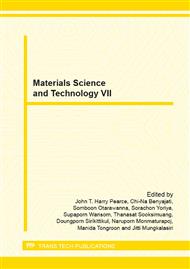[1]
A. K. Kondru, P. Kumar, and S. Chand, Catalytic wet peroxide oxidation of azo dye (Congo red) using modified Y zeolite as catalyst, J. Hazard. Mater. 166 (2009) 342–347.
DOI: 10.1016/j.jhazmat.2008.11.042
Google Scholar
[2]
M. Dükkanci, G. Gündüz, S. Yilmaz, Y. C. Yaman, R. V. Prikhod'ko, and I. V. Stolyarova, Characterization and catalytic activity of CuFeZSM-5 catalysts for oxidative degradation of Rhodamine 6G in aqueous solutions, Appl. Catal. B Environ. 95 (2010) 270–278.
DOI: 10.1016/j.apcatb.2010.01.004
Google Scholar
[3]
J. H. Ramirez, C. A. Costa, L. M. Madeira, G. Mata, M. A. Vicente, M. L. Rojas-Cervantes, A. J. López-Peinado, and R. M. Martín-Aranda, Fenton-like oxidation of Orange II solutions using heterogeneous catalysts based on saponite clay, Appl. Catal. B Environ. 71 (2007) 44–56.
DOI: 10.1016/j.apcatb.2006.08.012
Google Scholar
[4]
S. Navalon, M. Alvaro, and H. Garcia, Heterogeneous Fenton catalysts based on clays, silicas and zeolites, Appl. Catal. B Environ. 99 (2010) 1–26.
DOI: 10.1016/j.apcatb.2010.07.006
Google Scholar
[5]
O. O. Söǧüt and M. Akgün, Treatment of textile wastewater by SCWO in a tube reactor, J. Supercrit. Fluids. 43 (2007) 106–111.
DOI: 10.1016/j.supflu.2007.04.007
Google Scholar
[6]
N. Gokulakrishnan, A. Pandurangan, and P. K. Sinha, Removal of citric acid from aqueous solution by catalytic wet peroxidation using effective mesoporous Fe-MCM-41 molecular sieves, J. Chem. Technol. Biotechnol. 82 (2007) 25–32.
DOI: 10.1002/jctb.1630
Google Scholar
[7]
I. A. Alaton, I. A. Balcioglu, and D. W. Bahnemann, Advanced oxidation of a reactive dyebath effluent: comparison of O3, H2O2/UV-C and TiO2/UV-A processes, Water Research. 36 (2002) 1143–1154.
DOI: 10.1016/s0043-1354(01)00335-9
Google Scholar
[8]
K. Wantala, S. Sthiannopkao, B. Srinameb, N. Grisdanurak, and K. W. Kim, Synthesis and characterization of Fe-MCM-41 from rice husk silica by hydrothermal technique for arsenate adsorption, Environ. Geochem. Health. 32 (2010) 261–266.
DOI: 10.1007/s10653-010-9292-z
Google Scholar
[9]
P. Tantriratna, W. Wirojanagud, S. Neramittagapong, K. Wantala, and N. Grisdanurak, Optimization for UV-photocatalytic degradation of paraquat over titanium dioxide supported on rice husk silica using Box-Behnken design, Indian J. Chem. Technol. 18 (2011) 363–371.
Google Scholar
[10]
K. Wantala, E. Khongkasem, N. Khlongkarnpanich, S. Sthiannopkao, and K.-W. Kim, Optimization of As(V) adsorption on Fe-RH-MCM-41-immobilized GAC using Box–Behnken Design: Effects of pH, loadings, and initial concentrations, Appl. Geochem. 27 (2012) 1027–1034.
DOI: 10.1016/j.apgeochem.2011.11.014
Google Scholar


